Abstract
• Background: Carbomerbased hydrogels with timolol maleate (T-Gel) were chosen to study the vehicle effect on ocular bioavailability. Pharmacokinetic profiles of T-Gel 0.05% (0.05% timolol), T-Gel 0.025% (0.025% timolol) and commercial timolol ophthalmic solution (TOS 0.1%; 0.1% timolol) were determined and compared. • Methods: A single dose was administered to rabbits' eyes. Timolol was determined by HPLC in aqueous humour, blood samples and washings of the ocular surface (as a measure of residence time). Sampling times were 0.5 h, 1 h and 4 h after instillation. • Results: Concentration versus time curves (AUC) of timolol in aqueous humour demonstrate no significant differences between TOS 0.1% and T-Gel 0.025% (P=0.19), whereas the difference between T-Gel 0.05% and TOS 0.1% is significant (P=0.006); the AUC ratio of T-Gel 0.05%:TOS 0.1%:T-Gel 0.025% was 2.14:1:0.87. Timolol blood levels were highest with TOS 0.1% at every time point. Peak levels occurred after 0.5 h with all test products; the ratio of peak levels (Cmax) for T-Gel 0.05%:TOS 0.1%:T-Gel 0.025% was 0.55:1:0.17. Timolol was detected in the washings up to 1 h after instillation of test products; the highest levels were observed after T-Gel 0.05%. • Conclusion: The new vehicle obviously improves the bioavailability of topically applied timolol.
Similar content being viewed by others
References
Burstein N, Anderson J (1985) Review: corneal penetration and ocular bioavailability of drugs. J Ocul Pharmacol 1: 309–326
Chang S-C, Lee VHL (1986) Vehicle factors influencing the systemic absorption of topically applied timolol in the pigmented rabbit. 1st National Meeting, American Association of Pharmaceutical Scientists 3; pp 865
Chrai SS, Robinson JR (1974) Ocular evaluation of methylcellulose vehicle in albino rabbits. J Pharm Sci 63: 1218–1223
Davies NM, Farr SJ, Hadgraft J, Kellaway IW (1991) Evaluation of mucoadhesive polymers in ocular drug delivery. I. Viscous solutions. Pharm Res 8: 1039–1043
Elena PP, Polzer H, Khosravi E (1993) Bioequivalence between timolol maleate formulated in ophthalmic solution (Timoptol) and a novel gel vehicle (T-Gel). Invest Ophthalmol Vis Sci 94: 14–90
Giroux J, Schrenzel M (1964) Hydrogels à base de polymères de l'acide acrylique. Essais galéniques et pharmacodynamiques. 2e communication. Pharm Acta Helv 39: 615–621
Gurny R, Ibrahim H, Aebi A, Buri P, Wilson CG, Washington N, Edman P, Camber O (1987) Design and evaluation of controlled release systems for the eye. J Control Rel 6: 367–373
Hui H-W, Robinson JR (1985) Ocular delivery of progesterone using a bioadhesive polymer.Int J Pharm 26: 203–213
Kyyrönen K, Urtti A (1990) Improved ocular:systemic absorption ratio of timolol by viscous vehicle and phenylephrine. Invest Ophthalmol Vis Sci 31: 1827–1832
Lee VHL (1990) Review: new directions in the optimization of ocular drug delivery. J Ocul Pharmacol 6: 157–164
Mayer H, von der Ohe N (1993) Wirksamkeit von Timolol in neuartiger Gelformulierung. Ophthalmologe 90 [Suppl 1]: 103
Ohdo S, Grass G, Lee VHL (1991) Improving the ocular to systemic ratio of topical timolol by varying the dosing time. Invest Ophthalmol Vis Sci 32: 2790–2798
Patton T, Robinson J (1975) Ocular evaluation of polyvinyl alcohol vehicle in rabbits. J Pharm Sci 64: 1312–1316
Robinson JR, Li VHK (1984) Ocular disposition and bioavailability of pilocarpine from piloplex and other sustained release drug delivery systems. In: Tich U, David R (eds) Recent advances in glaucoma. Elsevier, Amsterdam, pp 231–236
Ros FE, Innemee HC, Van Zwieten PA (1979) Ocular penetration of β-adrenergic blocking agents. An experimental study with atenolol, metoprolol, timolol and propranolol. Doc Ophthalmol 48: 291–301
Rozier A, Mazuel C, Grove J, Plazonnet B (1989) Gelrite: a novel ion-activated, in-situ gelling polymer for ophthalmic vehicles. Effect on bioavailability of timolol. Int J Pharm 57: 163–168
Saettone MF, Chetoni P, Torracca MT, Burgalassi S, Giannaccini B (1989) Evaluation of muco-adhesive properties and in vivo activity of ophthalmic vehicles based on hyaluronic acid. Int J Pharm 51: 203–212
Saettone MF, Giannaccini B, Barattini F, Tellini N (1982) The validity of rabbits for investigations on ophthalmic vehicles: a comparison of four different vehicles containing tropicamide in humans and rabbits. Pharm Acta Helv 57: 47–55
Saettone MF, Giannaccini B, Teneggi A, Savigni P, Tellini N (1982) Vehicle effects on ophthalmic bioavailability: the influence of different polymers on the activity of pilocarpine in rabbit and man. J Pharm Pharmacol 34: 464–466
Saettone MF, Giannaccini B, Ravecca S, La Marca F, Tota G (1984) Polymer effects on ocular bioavailability — the influence of different liquid vehicles on the mydriatic response of tropicamide in humans and in rabbits. Int J Pharm 20: 187–202
Saettone MF, Giannaccini B, Guiducci A, Savigni P (1986) Semisolid ophthalmic vehicles. 111. An evaluation of four organic hydrogels containing pilocarpine. Int J Pharm 31: 261–270
Schmitt CJ, Lotti VJ, Le Douarec JC (1980) Penetration of timolol into the rabbit eye. Measurements after ocular instillation and intravenous injection. Arch Ophthalmol 98: 547–551
Schoenwald RD, Boltralik JJ (1979) A bioavailability comparison in rabbits of two steroids formulated as high-viscosity gels and reference aqueous preparations. Invest Ophthalmol Vis Sci 18: 61–66
Schoenwald RD, Ward RL, De Santis LM, Roehrs RE (1978) Influence of high-viscosity vehicles on miotic effect of pilocarpine. J Pharm Sci 67: 1280–1283
Schrenzel M (1964) Hydrogels à base de polymères de l'acide acrylique. Essais galéniques et pharmacodynamiques. lère communication. Pharm Acta Helv 39: 546–555
Vareilles P, Silverstone D, Plazonnet B, Le Douarec J-C, Sears ML, Stone CA (1977) Comparison of the effects of timolol and other adrenergic agents on intraocular pressure in the rabbit. Invest Ophthalmol Vis Sci 16: 987–996
Author information
Authors and Affiliations
Additional information
Presented at the ECORA Meeting in Bonn on 4 October 1993
Rights and permissions
About this article
Cite this article
von der Ohe, N., Stark, M., Mayer, H. et al. How can the bioavailability of timolol be enhanced? A pharmacokinetic pilot study of novel hydrogels. Graefe's Arch Clin Exp Ophthalmol 234, 452–456 (1996). https://doi.org/10.1007/BF02539412
Received:
Revised:
Accepted:
Issue Date:
DOI: https://doi.org/10.1007/BF02539412




